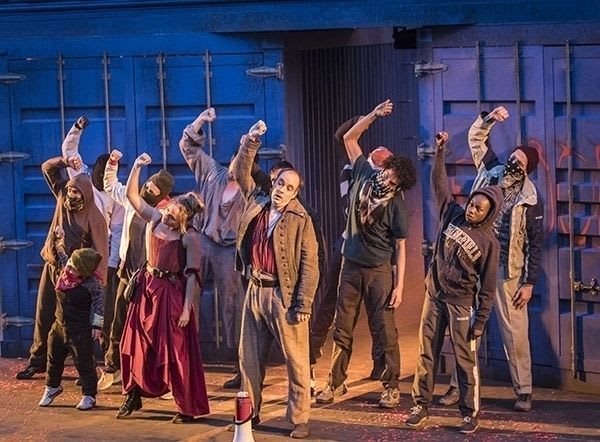When Jeremy Corbyn visited the scene of the Grenfell Tower fire, he described Kensington as “a tale of two cities—it is among the wealthiest parts of this country but the ward where this took place is one of the poorest.”
That stark and terrible contrast is there in Dickens's novel A Tale Of Two Cities and very powerfully in Matthew Dunster’s adaptation.
The play opens with suspicious looking men opening the back of a huge shipping container from which emerge a group of dazed refugees.
The early part of the play has many such images. There is the long line of refugees walking painfully round the revolving stage which is dominated by three enormous metal shipping trailers, one of which sits on top of a triangle formed by the other two.
A group of seven stands facing the side of a container, their legs spread, their arms held up above them as if waiting to be frisked by some guard.
The back of a container opens to reveal a space crammed with refugees rocking as if in a boat. Two screens either side of the stage emphasise the point with images of refugees at sea and others fleeing the horror of war.
This is no cosy costume Dickens. It is a tale of today with a mixture of clothes from now and the period Dickens was writing about. The language is also modernised.
Yet the story is still Dickens. A French man renounces his brutal family, gets a doctor released from prison, falls in love with the doctor’s daughter and faces trials in court that could result in his execution first in England and later in revolutionary France.
The one significant change from the novel takes place at Calais when a group of English and French people fleeing the terror of France are processed by British border guards who behave more in keeping with the current xenophobia of the British State than with the book Dickens wrote.
This is a play about injustice to the poor and cruelty to refugees. Matthew Dunster says it is also “about an explosion that is inevitable when people are brutally oppressed.”
On the screens, we see images of wealth, footage of Cameron, grand building projects in the city and a tower block in flames. There are also flashes of the London riots.
As the evening in the outdoor theatre grows darker, Lee Curran’s imaginative lighting design and Christopher Shutt’s moving sound design more strongly underscore the emotional impact of events depicted.
This is a powerful ensemble performance from a strong multicultural cast that is choreographed by Liam Steel into some extraordinary visual scenes, from the court of England to the revolutionary struggle in Paris.
Writing in the programme about the Grenfell fire, Matthew Dunster says it “perhaps could have been avoided if the lives of the poorest members of our society were valued differently... Our cast... know the London of the Grenfell residents. They were deeply affected and wanted to bring their feelings and experiences into the work.”
Stylistically, the show is modern, Brechtian and angry.
Anyone who loves theatre and craves social justice should see this fine production.
